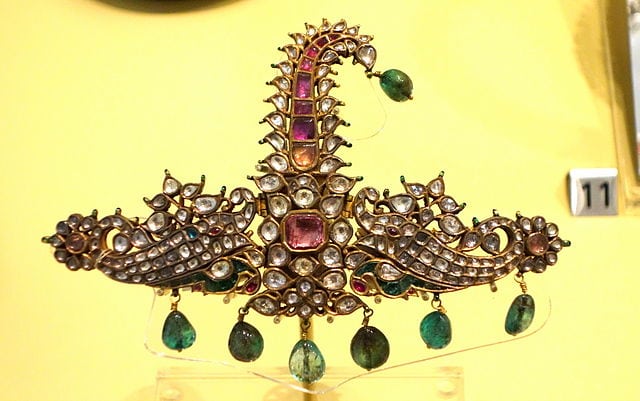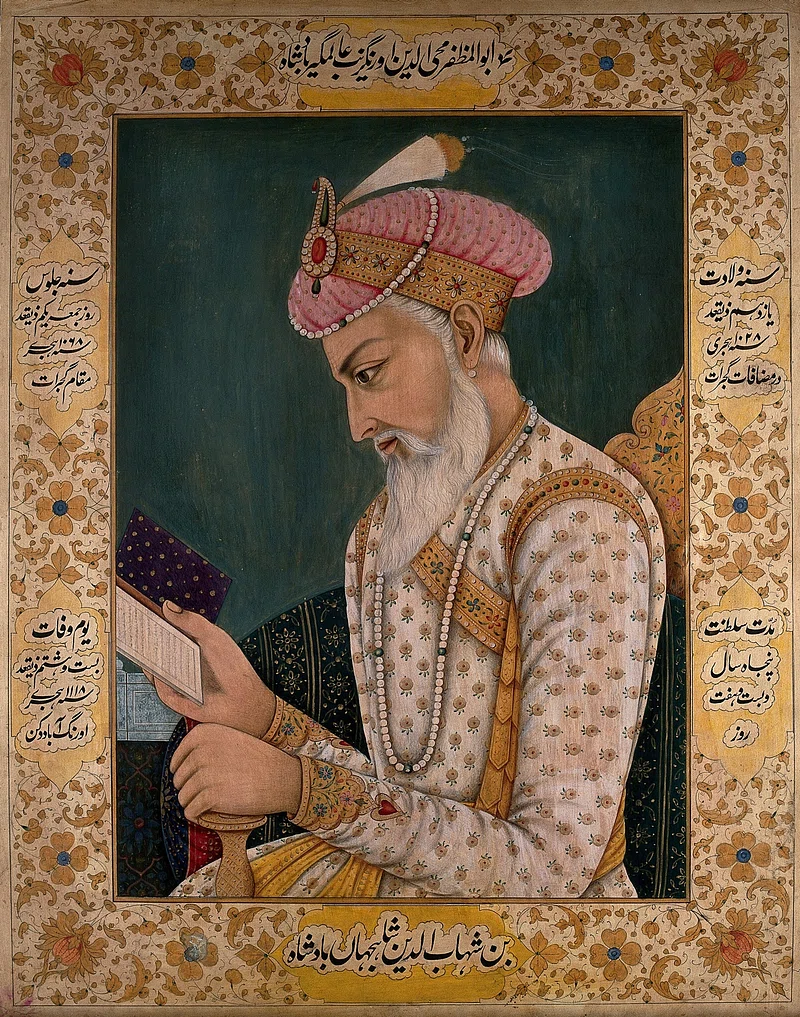When it comes to flaunting status, power, and an unmatched sense of style, India‘s royal families knew exactly how to crown their achievements—literally. From jewel-encrusted mukuts to feather-plumed turbans, royal headgear was a statement, a legacy, and sometimes, an impressive way to hold up some serious bling.

The Mukut, King of All Crowns and the Sparkle of Royal Tiaras
The Mukut was a masterpiece of gold and gemstones, crafted with meticulous care and a dash of divine inspiration. Adorned with rubies, emeralds, diamonds, and sapphires, this conical crown wasn’t just reserved for kings—it was reserved for emperors. Pearl borders and dangling pearl strands added the final touch of opulence, because, royalty does not stop at “just enough”.
Take, for example, the Jigha of Nawanagar, an all-diamond showstopper remodelled by Cartier in 1935. This breathtaking turban ornament epitomises the splendour of Indian royalty and the artistry of high jewellery. The all-diamond showstopper was commissioned by the Maharaja of Nawanagar, a renowned connoisseur of gems and luxury. The piece, set in white gold, showcases an exquisite array of diamonds meticulously arranged to create an opulent yet refined aesthetic. This rare masterpiece, once adorning the turban of one of India’s most illustrious rulers, remains an enduring symbol of regal extravagance and Cartier’s legacy in haute joaillerie.
The Satara Royal Pagdi was the ultimate statement piece, elevating royal headwear to an unmatched level of opulence. Embellished with 200 diamonds, 17 emeralds, and a trailing string of pearls, this magnificent turban was a declaration of power, prestige, and impeccable taste. The pièce de résistance was the string of pearls cascading elegantly behind, like a regal mic drop for anyone daring to question the monarch’s grandeur.
Crowning Achievements by Region
- Karnataka’s Mysore Peta: These silk turbans, wrapped in golden-threaded lace, were the hallmark of the Wodeyar royal family. If subtlety was ever an option, the Wodeyars clearly did not want it.
- Rajasthan’s Pagaris: Royal Rajasthani turbans were engineering marvels, with some weighing more than your average watermelon.
- Punjab’s Dastar: A symbol of strength and pride, the Sikh turban influenced headgear design far and wide. Maharaja Ranjit Singh’s variations came with middle dips and neck flaps for added style.
The Mughal Masterpieces
The Mughals were known for their love of grandeur and their ability to transform the everyday into the extraordinary, and their approach to headgear was no exception. They elevated turbans from simple accessories to breathtaking symbols of power, art, and craftsmanship.

The Mughal passion for opulence reached new heights with the Kalgi, an ornate turban ornament that became a hallmark of royalty. These jewelled creations, often featuring exquisite gemstones set into elaborate designs and adorned with delicate plumes, added an undeniable sparkle to their already magnificent attire. Reserved primarily for the emperor, the Kalgi symbolized power and prestige. On rare occasions, it was gifted to favoured nobles or princes, making it a token of immense honour.
Through their elaborate turbans and ornaments, the Mughal emperors turned headgear into a canvas of artistic expression. Each piece reflected their status, taste, and the empire’s unmatched ability to blend symbolism with luxury. In their hands, headgear was a masterpiece that spoke of power, legacy, and a love for all things extraordinary.
Emeralds: The Royal Obsession
Emeralds, or “Tears of the Moon” as Mughal emperors poetically called them, were the jewels of choice. Whether inscribed with sacred verses by Shah Jahan or simply flaunted on a massive scale by the Maharaja of Kapurthala, these green beauties spelt sophistication.
Shah Jahan, the emperor who gave the world the Taj Mahal, also had an eye for these treasures. A 1628 portrait shows him holding a colossal emerald-like it was a personal trophy, cementing its status as a jewel of both visual and symbolic weight. These emeralds hailed from South America, making them exotic imports that doubled as status symbols in the Mughal court.
Of course, they didn’t just stop at necklaces or rings. Enter the sarpech, the jewelled turban ornament that defined Mughal fashion. These elaborate brooch-like pieces, framed by feathered plumes, were reserved for emperors and occasionally bestowed upon the crème de la crème of the court. Emeralds were always the headliners in these dazzling designs.
Fast forward to the princely states, where Maharaja Jagatjit Singh of Kapurthala turned jewellery into an art form. Known for his impeccable taste, he commissioned a Belle Époque emerald and diamond brooch that doubled as a turban ornament. His wife, Anita Delgado, famously flaunted this masterpiece at official events, proving that emeralds were as much about royal charm as they were about timeless style. This stunning creation was a perfect blend of traditional Indian aesthetics and European finesse—a true testament to the Maharaja’s eclectic tastes.
For Indian royalty, emeralds were a statement, a connection to global trade, and a symbol of divine rule. Whether Shah Jahan was admiring his emerald in the Mughal court or the Maharaja of Kapurthala was dazzling European royals with his turban ornaments, one thing was clear: emeralds were the ultimate showstopper.
Kings Who Took Headgear to the Next Level
When it came to flaunting authority and wealth, Indian royals knew how to bring in star power. Their headgear was a statement of power, style, and, let’s be honest, some jaw-dropping dazzling headpieces that graced history.
Emperor Humayun and Taj-i-Izzat
Emperor Humayun was a trendsetter in his time, introducing the Taj-i-Izzat, or “Crown of Glory,” a turban design that became synonymous with his reign. Its distinctive pointed style was a departure from the traditional Mughal turbans, standing as a bold statement of his authority and vision.
Shah Jahan – a headgear ornament of unparalleled grandeur
Perhaps no emperor embodied the Mughal love for luxury better than Shah Jahan, the visionary behind the Taj Mahal. His Sarpech, a dazzling ornament crafted with emeralds and diamonds on his turban, exemplified his penchant for intricate craftsmanship and unparalleled grandeur.
Nizam of Hyderabad: A Sarpech for the Ages
The Nizam’s sarpech (turban ornament) was nothing short of legendary. Crafted with five intricate openwork foliate diamond panels and encased in gold, it featured nine emerald drops that hung like green teardrops of envy. The craftsmanship was unmatched, reflecting the grandeur of the Hyderabad court.
Maharaja of Kapurthala: Cartier’s Masterpiece
Maharaja Jagatjit Singh was not one to settle for ordinary. His Cartier headdress, a Belle Époque creation, boasted a massive 117.40-carat hexagonal emerald as its centrepiece, surrounded by 19 smaller emeralds, pearls, and white diamonds. This masterpiece was so stunning that it became a showstopper at royal events for King George V and VI. Talk about a head-turner!
Patiala Royal Sarpech: A Rainbow of Riches
The Patiala royal family’s sarpech was a kaleidoscope of opulence, adorned with diamonds, rubies, emeralds, and intricate enamel work in red, green, and blue. Its foliate motif design added a touch of elegance. Sold at Christie’s in 1999, this heirloom continued to dazzle even outside royal circles.
Maharaja of Ratlam (Ranjit Singhji): The Jewels of Precision
The Maharaja’s dastar (turban) wasn’t just a headpiece; it was a treasure trove. A mesh of intricate sarpattis made of diamonds, pearls, and precious gemstones wrapped around his turban, punctuated by circular diamond-encrusted brooches. The jewel game didn’t stop there—his portraits often revealed an elaborate kundan haar (necklace), a pearl choker, and diamond earrings. To top it off, his angarkha (traditional coat) shimmered with gold-thread embroidery and sequins, while a jewelled sword hinted at his royal swagger.
The Gaekwads of Baroda – a dazzling emerald aigrette
The Gaekwads of Baroda took emerald devotion to dazzling heights. In the 1860s, the Maharaja wore a ceremonial necklace adorned with diamonds and emeralds, a creation that showcased the state’s wealth and cultural prominence.Later, Maharaja Pratap Singh Rao Gaekwad wore an emerald aigrette—a feathered turban ornament inspired by European design—seamlessly blending global elegance with Baroda’s royal traditions.
Maharaja of Benares (Prabhu Narayan Singh): A Legacy of Simplicity and Wealth
Though fewer details survive about his specific headgear, the Maharaja of Benares was part of a lineage that treasured their collection of diamonds and gemstones. Known for their simplicity paired with exquisite taste, his headpieces reflected the understated elegance of Benares royalty, focusing more on cultural and ceremonial significance than flashy embellishments.

The Wodeyars of Mysore – a cultural icon
The Wodeyars of Mysore didn’t hold back either. Their Mysore Peta was a bejewelled silk turban that doubled as a status symbol. Maharaja Jayachamaraja Wodeyar wore his Peta with such swagger that it became a cultural icon, often gifted as an honour to esteemed guests.
Feather Power
Feathers and plumes on royal headgear were like the mic drop of monarchy—loud, proud, and impossible to ignore. From black egret feathers to peacock plumes, these additions transformed turbans into symbols of divine authority and unmatched swagger.
For the Mughals, feather plumes were declarations. Emperor Humayun’s Taj-i-Izzat featured an iconic black egret plume, shouting, “Bow down, I’m the boss.” Akbar, always on trend, opted for an upright plume in his turban, inspired by Iranian aesthetics, while Jahangir took it up a notch with softer plumes weighted down by pearls, proving even feathers could have layers of luxury. The kalgi, a jewelled turban ornament crowned with feathers, became a Mughal signature, reserved exclusively for emperors and gifted to only the most elite courtiers as political statements.
In the Sikh Empire, the kalgi took on a spiritual and royal flair. Maharaja Ranjit Singh rocked slender black heron feathers on his turban, a nod to the heritage of Guru Gobind Singh, who popularized the plume as a symbol of temporal authority. These plumes carried the weight of Sikh sovereignty and tradition.
Rajput kings weren’t ones to shy away from grandeur. Their pagris (turbans) featured peacock plumes, adding a touch of elegance to their warrior swagger. Each feather was a bold proclamation of lineage, bravery, and the unshakable pride of their clans. For Rajputs, the more elaborate the plume, the higher the honour.
Chhatrapati Shivaji Maharaj and the Maratha rulers used feathered headgear to symbolize their sovereignty and military prowess. The plumes were always prominently displayed, serving as a visual representation of their martial dominance and authority over their territories.
Legacy of the Bejeweled Turban
From the Nizam of Hyderabad’s diamond-drenched sarpechs to Maharaja of Jodhpur’s winged turban designs, India’s royal headgear wasn’t just about accessorizing—it was about making history. Today, these masterpieces remain as shimmering relics of a bygone era, ensuring that long after their wearers are gone, their crowns still reign supreme.
So, the next time you think your accessories are on point, remember the Maharajas of India, who truly put the “crown” in “crown jewel.”
Read More: Latest



